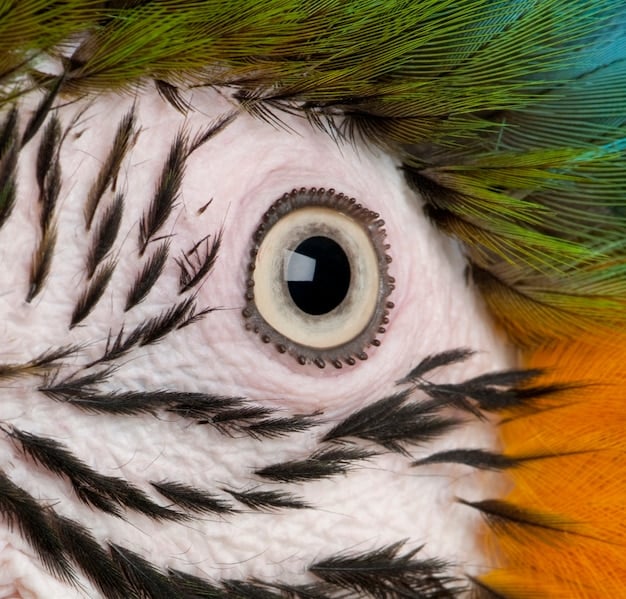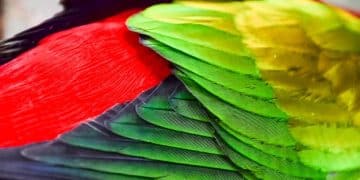Unlocking Animal Navigation: Magnetic Fields and Landmarks

The science of animal navigation explores how animals use various cues like magnetic fields and landmarks to find their way across vast distances, ensuring survival and successful migration.
Ever wondered how birds migrate thousands of miles, or how sea turtles return to the same nesting beach year after year? The secret lies in the intriguing science of animal navigation: How Animals Use Magnetic Fields and Landmarks, a complex interplay of sensory perception and environmental cues.
Animal Navigation: Decoding the Natural GPS
Animal navigation is a fascinating field that delves into the methods animals use to determine their position and direction. From the smallest insects to the largest whales, animals employ a variety of strategies to navigate their environment. Understanding these mechanisms can provide insights into their behavior, ecology, and evolutionary adaptations.
What is Animal Navigation?
Animal navigation refers to the ability of an animal to accurately determine its position and navigate from one location to another, often over long distances.
Why is Navigation Important?
Effective navigation is crucial for survival, allowing animals to find food, locate mates, avoid predators, and migrate to suitable breeding grounds.

To navigate successfully, animals must rely on a combination of innate abilities and learned behaviors. These strategies often involve using environmental cues to orient themselves and maintain a sense of direction. Some common cues include:
- Magnetic Fields: Many animals can detect the Earth’s magnetic field and use it as a compass.
- Landmarks: Visual cues such as mountains, rivers, and coastlines serve as important navigational markers.
- Celestial Cues: The position of the sun, moon, and stars can provide directional information, especially during migration.
In conclusion, animal navigation is a complex process that relies on a variety of sensory inputs and cognitive abilities. By understanding the different strategies animals use to navigate, we can gain a deeper appreciation for their remarkable adaptations and behaviors.
The Earth’s Magnetic Field: A Natural Compass
One of the most remarkable aspects of animal navigation is the ability of many species to detect and use the Earth’s magnetic field. This magnetic sense, known as magnetoception, provides animals with a constant and reliable source of directional information, even in the absence of visual cues.
How Does Magnetoception Work?
The exact mechanisms behind magnetoception are still being investigated, but two main hypotheses have emerged:
- Chemical Magnetoreceptors: Some animals may have specialized cells containing light-sensitive proteins called cryptochromes. These proteins are thought to be involved in detecting the Earth’s magnetic field through chemical reactions.
- Magnetic Particle Receptors: Other animals may possess cells containing tiny particles of magnetite (a magnetic mineral). These particles could physically interact with the Earth’s magnetic field, providing the animal with directional information.
Examples of Magnetic Navigation
Several species are known to use magnetic fields for navigation:
- Birds: Many migratory birds use the Earth’s magnetic field as a primary compass during long-distance flights.
- Sea Turtles: Hatchling sea turtles use magnetic fields to orient themselves in the ocean and find their way to specific feeding grounds.
- Salmon: Salmon are believed to use magnetic fields to return to their natal streams to spawn.
In summary, the Earth’s magnetic field provides a crucial navigational cue for many animals, allowing them to orient themselves and travel long distances with remarkable accuracy. The precise mechanisms of magnetoception are still under investigation, but it appears to involve specialized cells containing either chemical magnetoreceptors or magnetic particle receptors.
Using Landmarks for Route-Finding
While magnetic fields provide a global compass, many animals also rely on local landmarks to navigate their environment. Landmarks are visual cues, such as mountains, rivers, and distinctive rock formations, that serve as navigational markers.
Visual Landmarks
Animals can use a variety of visual cues to navigate, including:
- Mountains: Large, prominent mountains can be seen from long distances and serve as important directional markers.
- Rivers: Rivers and other bodies of water provide linear features that can be followed or crossed to reach a specific destination.
- Coastlines: Coastlines offer a clear boundary between land and sea, helping animals maintain their orientation along migratory routes.
Olfactory Landmarks
In addition to visual landmarks, some animals also use olfactory landmarks to navigate. These olfactory cues can be especially important for animals that live in dense forests or underground environments.

Cognitive Maps
Animals use a combination of landmarks and memory to create cognitive maps of their environment. These maps allow them to plan routes, find shortcuts, and return to familiar locations. Landmark recognition enhances navigation in complex terrains by providing recognizable points along travel paths.
In conclusion, landmarks offer crucial visual and olfactory cues aiding animals in navigation by confirming direction and proximity to targets. Cognitive maps make navigation more flexible, enabling animals to adjust travel based on their memory and position to recognizable markers.
Migration and Navigation: A Symbiotic Relationship
Migration, the seasonal movement of animals from one region to another, is a complex behavior that relies heavily on accurate navigation. Migratory animals often travel vast distances, crossing continents and oceans to reach suitable breeding or feeding grounds.
The Role of Navigation in Migration
Successful migration depends on two key navigational abilities:
- Orientation: The ability to determine and maintain a sense of direction.
- Homing: The ability to return to a specific location after traveling a long distance.
Examples of Migratory Navigation
Several species demonstrate remarkable navigational abilities during migration:
- Arctic Terns: These birds undertake the longest migration of any animal, traveling from the Arctic to the Antarctic and back each year. They use a combination of magnetic fields, celestial cues, and landmarks to guide them.
- Monarch Butterflies: Monarch butterflies migrate thousands of miles from Canada and the United States to overwintering sites in Mexico. They use a combination of magnetic fields and solar cues to navigate.
- Humpback Whales: Humpback whales migrate from polar feeding grounds to tropical breeding grounds each year. They are believed to use magnetic fields and acoustic cues to navigate.
In brief, navigation is crucial for migration allowing animals to travel to required locales by utilizing orientation and homing. Arctic Terns, Monarch Butterflies, and Humpback Whales utilize multiple cues like magnetic fields, celestial guidance, and landmarks to complete the cycle.
The Impact of Human Activities on Animal Navigation
Human activities, such as habitat destruction, pollution, and climate change, can have a significant impact on animal navigation. These activities can disrupt the environmental cues that animals rely on to navigate, leading to disorientation, increased mortality, and reduced reproductive success.
Habitat Destruction
Habitat destruction can remove or alter landmarks that animals use to navigate. For example, the clearing of forests can eliminate visual cues that birds use to orient themselves, while the construction of dams can disrupt the flow of rivers, making it difficult for salmon to return to their spawning grounds.
Pollution
Light and noise pollution can interfere with animal navigation. Artificial light can disorient nocturnal animals, while excessive noise can mask acoustic cues that animals use to communicate and navigate.
Climate Change
Climate change can alter the distribution of resources and habitats, forcing animals to migrate to new areas. However, the rate of climate change may be too fast for some animals to adapt, leading to mismatches between their navigational abilities and the changing environment.
In order to protect animal navigation, it is crucial to address the impacts of human activities on the environment. This can be achieved through:
- Habitat Conservation: Protecting and restoring natural habitats to maintain the cues that animals use to navigate.
- Pollution Reduction: Reducing light and noise pollution to minimize interference with animal navigation.
- Climate Change Mitigation: Reducing greenhouse gas emissions to slow down the rate of climate change and allow animals to adapt.
In conclusion, human activities could damage and confuse navigation strategies used by animals and lead to imbalances within ecosystems and reduced biodiversity. Focused conversation measures will help preserve natural habitats, lessen climate related pollution, and reduce the pace of environmental changes helping animals better adapt.
Future Directions in Animal Navigation Research
The study of animal navigation remains an active and exciting field of research. As technology advances and new discoveries are made, scientists are continually refining our understanding of how animals navigate their world.
Emerging Technologies
Several emerging technologies are being used to study animal navigation, including:
- GPS Tracking: Miniature GPS trackers can be attached to animals to record their movements in detail, providing insights into their navigational strategies.
- Remote Sensing: Satellite imagery and other remote sensing technologies can be used to map habitats and track environmental changes that may affect animal navigation.
- Virtual Reality: Virtual reality environments can be used to simulate different navigational scenarios and test how animals respond to various cues.
Unanswered Questions
Despite significant advances in our understanding of animal navigation, several unanswered questions remain:
- What are the precise mechanisms behind magnetoception?
- How do animals integrate different navigational cues to create a coherent sense of direction?
- Can animals adapt to rapid environmental changes and maintain their navigational abilities?
Future studies will seek to answer these open questions to further understand animal navigational abilities. Researchers may focus on a combination of advanced tracking technologies such as GPS along with developing innovative virtual reality simulations. These research studies will reveal vital data to aid in efforts to conserve and promote wildlife.
| Key Concept | Brief Description |
|---|---|
| 🧭 Magnetic Fields | Animals use Earth’s magnetic field for orientation. |
| 🏞️ Landmarks | Visual and olfactory markers guide animals. |
| ✈️ Migration | Navigation crucial for seasonal movements. |
| 🌍 Human Impact | Activities disrupt cues & routes; conservation needed. |
Frequently Asked Questions
Birds use specialized photoreceptors, called cryptochromes, in their eyes that detect variations in Earth’s magnetic field, enabling them to orient themselves during long migrations. Changes in the magnetic field provide positional information.
Animals rely on visual landmarks, such as mountains and rivers, as well as olfactory cues to find their way. Animals might also incorporate celestial signals, like the sun or moon, to aid in journeys.
Pollution, especially light and noise, can confuse animals. Light pollution disorients nocturnal species, while increased noise interferes with communication and the ability to detect natural cues from the environment, such as migratory routes.
Cognitive maps allow the memorization of landmarks and routes, thus assisting animals to flexibly navigate even when confronted with obstacles or changes in circumstances. These maps help animals to take shortcuts or find detours.
Studying animal navigation provides insights into animal behavior, migration habits, and sensory capabilities. Understanding these navigation strategies is critical for conservation efforts, especially in protecting species affected by climate change and habitat destruction.
Conclusion
Understanding the science of animal navigation provides a window into the remarkable sensory and cognitive abilities of the animal kingdom. By detecting magnetic fields, interpreting landmarks, and using various other cues, animals can navigate with precision and endurance, completing incredible journeys essential for survival. Protecting these navigational cues and the habitats that support them is vital to preserving biodiversity and ensuring the success of future generations of migratory species.





